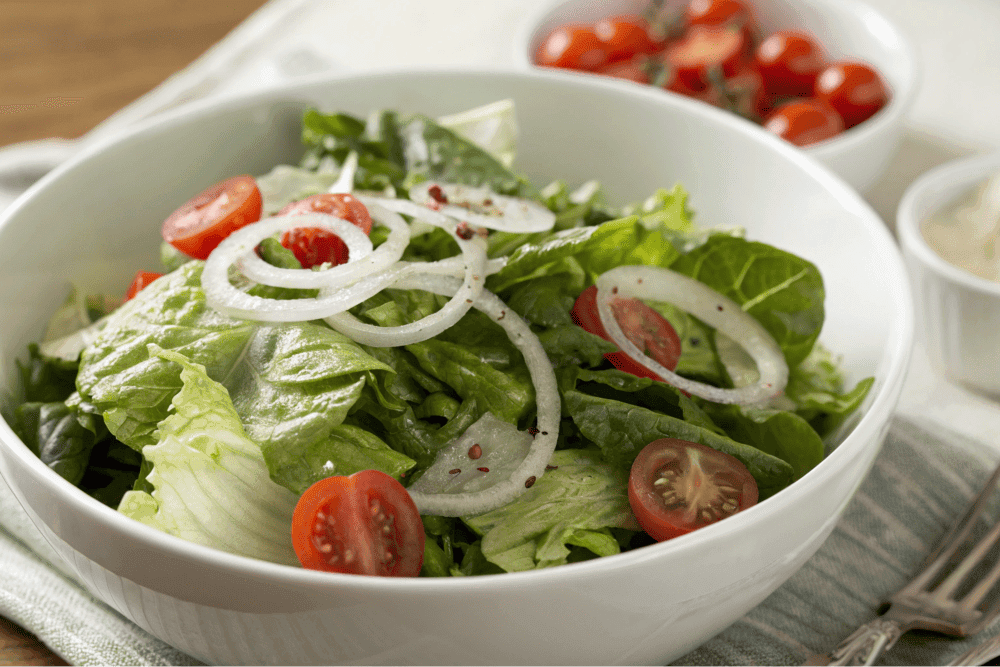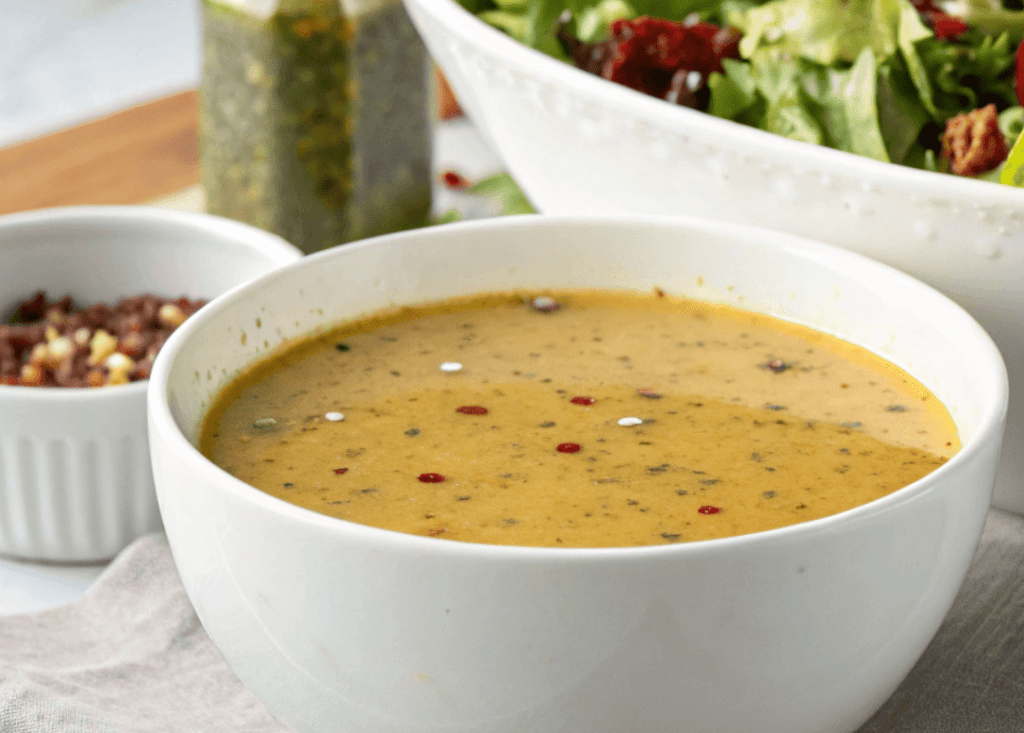New Orleans soaked salad dressing is not just another salad topping—it’s an explosion of flavors that brings a unique Creole twist to your salads. With its tangy vinegar base, fresh herbs, and distinctive seasonings, this dressing is perfect for those looking to add a bit of Southern flair to their meals. Whether you’re making a simple green salad or serving it with grilled seafood, this dressing is sure to be a hit.
What Is New Orleans Soaked Salad Dressing?
New Orleans soaked salad dressing is a tangy, herb-infused vinaigrette that truly transforms salads by soaking into the greens, creating a delicious marinated effect. Furthermore, it is crafted with vinegar, olive oil, and fresh herbs like basil and parsley, which together capture the bold essence of Creole cuisine. Additionally, this unique “soaked” approach allows each ingredient to absorb the flavors, resulting in a deeper and more vibrant taste. Consequently, it is perfect not only for salads but also for seafood and other dishes, making it an excellent way to infuse your meals with Creole flair.
Why New Orleans Soaked Salad Dressing Stands Out
What truly sets New Orleans soaked salad dressing apart is its remarkable ability to infuse greens with rich, vibrant flavors. By allowing the dressing to sit and soak into the vegetables, it gradually enhances the taste, resulting in a delightful tang that effortlessly elevates any salad. Moreover, this Creole classic not only enhances fresh salads but also pairs beautifully with grilled seafood and other dishes.
Additionally, this dressing stands out for its simplicity and versatility, making it a beloved staple in Creole cuisine. With its fresh herbs, bold spices, and sharp acidic tang, it effectively captures the essence of New Orleans. For those who enjoy tangy and zesty flavors, this recipe offers a refreshing twist on the traditional vinaigrette. Consequently, whether drizzled over greens or served alongside seafood, this dressing consistently delivers a bold and unforgettable taste experience.
Ingredients You’ll Need
To make a delicious New Orleans soaked salad dressing recipe, you’ll need the following basic ingredients:
- Olive oil – The base for your dressing, providing a smooth and rich texture.
- Vinegar – Either apple cider vinegar or white wine vinegar will work, adding the tanginess.
- Lemon juice – Freshly squeezed lemon juice adds a bright, fresh note.
- Garlic – A small clove of garlic, minced or finely chopped, gives depth to the dressing.
- Fresh herbs – Basil, parsley, and oregano are the most common herbs used in this dressing.
- Black pepper – To add a bit of heat and enhance the overall flavor.
- Sugar – Just a pinch to balance the acidity from the vinegar and lemon juice.
- Salt – To taste, enhancing the overall flavor.
Each of these ingredients plays a pivotal role in creating that rich, New Orleans-inspired flavor. You can even try pairing it with other dishes like our Cottage Cheese Chips Recipe for a unique snack pairing.
Optional Ingredients
- Hot sauce – For those who like a bit of heat in their salad dressing.
- Chopped onions or tomatoes – To add texture and extra flavor.
- Mustard – For a slightly tangier and smoother texture.
This combination of ingredients seamlessly comes together to create a vibrant dressing that’s perfect for a variety of dishes. Moreover, the tanginess of the vinegar and lemon juice, paired with the freshness of the herbs, results in an irresistible flavor that elevates any meal.
Step-by-Step Instructions to Make New Orleans Soaked Salad Dressing Recipe
Making your own New Orleans soaked salad dressing is quick and easy. Follow these steps to make the perfect Creole-inspired dressing:
1. Prepare Your Salad Ingredients
- Wash and dry your greens thoroughly. You can use a variety of fresh greens, such as romaine, arugula, or spinach.
- If you’re adding other vegetables like tomatoes or onions, chop them up into bite-sized pieces for an added texture.

2. Mix the Dressing
- In a large bowl, whisk together the olive oil, vinegar, lemon juice, and garlic.
- Add in the fresh herbs—parsley, basil, and oregano—and stir to combine.
- Season the dressing with salt, black pepper, and a small pinch of sugar.
- Whisk until the dressing is smooth and well combined.
Optional Ingredients:
- Hot sauce – Adds a vibrant red hue and a slightly thinner consistency with a spicy kick.
- Chopped onions or tomatoes – Introduces a chunkier texture with bursts of fresh flavor and a splash of color.
- Mustard – Creates a creamier, slightly thicker dressing with a tangy finish.
Adding these optional ingredients can enhance both the appearance and flavor of your dressing, giving it a personalized touch to complement your salad!

3. Toss the Salad
- Pour the dressing over your prepared greens and toss gently to coat the vegetables evenly.
- Let the salad sit for about 30 minutes in the refrigerator. The longer it sits, the more flavorful the salad will become, as the dressing soaks into the greens.
This dressing can be used on a variety of salads, grilled vegetables, or even as a marinade. Moreover, it’s versatile, flavorful, and packs a punch! For instance, you can pair it with a hearty side dish like the Easy Kefir Sheet Cake Recipe, which perfectly complements the tangy flavor of the dressing. Additionally, for more creative meal ideas, consider experimenting with grilled meats or roasted potatoes to highlight the bold flavors of this dressing.
Serving Suggestions
This New Orleans soaked salad dressing pairs beautifully with a variety of dishes. Here are a few ideas:
- Grilled seafood – The tangy dressing complements seafood perfectly. Try it with grilled shrimp, crawfish, or seared fish.
- BBQ meats – The acidity of the dressing balances the richness of BBQ pork or ribs.
- Side salads – Serve it as a light, refreshing side salad with fresh greens like romaine or arugula.
How to Keep Your Salad Fresh
- To keep your salad fresh, dress only the amount of salad you plan to eat. If there’s leftover dressing, store it separately in an airtight container in the fridge.
- Leftover dressing can be stored in the fridge for up to a week. Just be sure to stir it well before using again.
Nutritional of New Orleans soaked salad dressing
Nutritional values may vary depending on specific quantities and brands used.
| Nutrient | Approximate Value per Serving (2 tablespoons) |
|---|---|
| Calories | 120-140 calories |
| Total Fat | 14g (mostly from olive oil, healthy unsaturated fats) |
| Saturated Fat | 2g |
| Cholesterol | 0mg |
| Sodium | 50-100mg (depending on the amount of salt) |
| Carbohydrates | 1-2g (primarily from sugar and optional vegetables) |
| Sugar | <1g |
| Protein | 0g |
| Vitamin A | Small amount (from fresh herbs like parsley) |
| Vitamin C | ~10% of the daily recommended intake (from lemon juice and optional tomatoes) |
| Vitamin K | ~15% of the daily recommended intake (from olive oil and herbs) |
| Calcium | Trace amounts (from herbs) |
| Iron | ~2% of the daily recommended intake (from olive oil and herbs) |
Adding hot sauce will slightly increase sodium.
Including chopped onions or tomatoes will raise Vitamin C and carbohydrate levels slightly.
Using mustard may increase sodium and provide additional flavor-enhancing nutrients.
For a healthier option, reduce the sugar and salt or use low-sodium mustard or hot sauce.
This dressing is a flavorful and nutritious choice, especially when made fresh with wholesome ingredients.
Variations of the New Orleans Soaked Salad Dressing Recipe
One of the best things about this dressing is how customizable it is. You can adjust it to your liking by adding various ingredients for a twist on the classic recipe.
Protein Additions
For a more substantial meal, add proteins such as grilled chicken, shrimp, or sausage. These additions will make your salad more filling and add a heartier flavor.
Spicy Options
If you love heat, add a few dashes of hot sauce or Cajun seasoning. The spiciness will enhance the bold flavors of the dressing, making it even more exciting.
Vegetarian Variations
If you’re looking for a vegetarian option, try adding ingredients like avocados, chickpeas, or roasted vegetables. These ingredients not only pair well with the dressing but also provide added texture and richness to the salad.
What is the unhealthiest salad dressing?
The unhealthiest salad dressing is typically one that is high in calories, sugar, and unhealthy fats, such as creamy dressings like ranch, blue cheese, or Caesar. These dressings often contain excessive amounts of saturated fats and added sugars, which can quickly turn a healthy salad into a calorie-laden meal. Additionally, many store-bought versions include preservatives and artificial ingredients, further reducing their nutritional value. Consequently, while these dressings may be tasty, opting for lighter alternatives like vinaigrettes or homemade versions with natural ingredients can significantly improve the healthiness of your salad.
What not to mix in salad?
Avoid these combinations in salads:
- Fruits with Creamy Dressings – Flavors may clash.
- Too Many High-Calorie Toppings – Limit cheese, nuts, and avocado.
- Sugary Ingredients – Skip candied nuts, dried fruits, and sugary dressings.
- Heavy Starches and Proteins – Avoid combining pasta, potatoes, and meats.
- Fried Items – Fried chicken or croutons add unhealthy fats.
- Overpowering Flavors – Don’t mix too many strong ingredients like olives and blue cheese.
Focus on balanced textures, fresh veggies, and light toppings!
Why you shouldn’t eat salad everyday?
While eating salad every day may seem like a healthy choice, it can have drawbacks if not done thoughtfully. For one, relying solely on salads might lead to an unbalanced diet, as they often lack essential nutrients like healthy fats, proteins, and complex carbohydrates that are crucial for overall health. Additionally, consuming raw vegetables daily can sometimes strain digestion, especially for individuals with sensitive stomachs. Moreover, repetitive eating can lead to food fatigue, making it harder to stick to healthy eating habits over time. Therefore, while salads are nutritious, it’s important to incorporate a variety of foods into your diet to ensure you’re meeting all your nutritional needs.
What to avoid in salad for weight loss?
To keep your salad weight-loss-friendly, avoid:
- High-Calorie Dressings – Skip creamy dressings; use light vinaigrettes instead.
- Fried Toppings – Opt for grilled proteins or roasted nuts instead of fried items.
- Excessive Cheese – Use small portions or skip it entirely.
- Sugary Add-Ins – Avoid dried fruits or candied nuts; choose fresh fruits.
- Processed Meats – Use lean proteins like grilled chicken or tofu.
- Refined Carbs – Skip croutons or white pasta; try whole grains instead.
- Too Much Salt – Limit salty toppings; use fresh herbs for flavor.
- Large Portions of Healthy Fats – Use avocado, nuts, or seeds sparingly.
Focus on fresh veggies, lean proteins, and light dressings for a healthy, weight-loss-friendly salad.
Frequently Asked Questions (FAQ)
Can I Make New Orleans Soaked Salad Dressing Recipe in Advance?
Yes, you can prepare the dressing ahead of time and store it in an airtight container in the fridge for up to a week. The flavors will deepen and meld together as it sits.
Can I Use Dried Herbs Instead of Fresh?
While fresh herbs are recommended for the best flavor, you can use dried herbs if necessary. Just be sure to use half the amount of dried herbs as you would fresh.
What’s the Difference Between Soaked Salad Dressing and Regular Vinaigrette?
Soaked salad dressing is specifically designed to marinate the salad, allowing the flavors to fully infuse into the greens for a richer, more intense taste. In contrast, regular vinaigrette simply sits on top of the salad, coating the surface without fully soaking in. Consequently, the soaked approach offers a deeper and more satisfying flavor experience.
How Long Should I Let the Salad Soak?
For the best flavor, let the salad sit for at least 30 minutes before serving. The longer it soaks, the more the flavors will develop.
Conclusion
The New Orleans soaked salad dressing recipe is an easy and delicious way to elevate your meals. Thanks to its tangy, herb-infused flavor, it’s perfect not only for salads but also for grilled seafood, BBQ dishes, and more. Whether you’re looking to add a bit of New Orleans flair to your next meal or simply want a unique salad dressing, this recipe is a fantastic choice. Moreover, it’s versatile, packed with flavor, and sure to become a favorite in your kitchen.
In addition, for more inspiration on how to use bold flavors in your cooking, you can check out a variety of delicious Southern recipes on Southern Living or explore New Orleans’ culinary websites. With so many flavorful options, you’ll never run out of exciting dishes to try. Happy cooking!

